Zotac's Ion: The World's First mini-ITX Ion Board
by Anand Lal Shimpi on May 12, 2009 12:00 AM EST- Posted in
- GPUs
Putting It in Perspective: The Atom Takes on a Single-Core Pentium 4
When the Atom first appeared I immediately did my best to characterize its performance. Intel always referred to it as having the performance of a 90nm Pentium M but never really got as specific as I would like. In my subsequent testing I found that at 1.6GHz, Intel’s Atom performed like a 1.2GHz 90nm Pentium M (Dothan). If you had a Pentium M notebook back then, the comparison makes sense to you. If you didn’t, however, then you’d need another reference point.
I realized I had no idea how Atom compared to an old Pentium 4. To remedy the situation I dug up an old Dell based on a single-core, Northwood based (130nm) Pentium 4 running at 2.66GHz. These chips used a 533MHz FSB and had a 512KB on-die L2 cache. The system had an ATI Radeon X800 XT and 2GB of DDR memory. This Pentium 4 did not have Hyper-Threading, this was before HT made its official desktop debut.
For my first test I turned to Adobe Photoshop CS4:
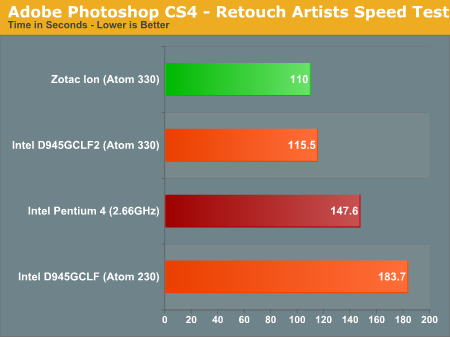
Wow. This is huge. Intel’s dual-core Atom 330 is 25% faster than the 2.66GHz Pentium 4. The advantage is all in the extra core though. If you look at the Atom 230 the Pentium 4 beats it by almost 20%.
Next I wanted to look at video encoding performance, one of the Pentium 4’s strongpoints. If you remember back then, even the Athlon 64 had difficulty competing with the P4’s encoding prowess. We’ll start with Windows Media Encoder:
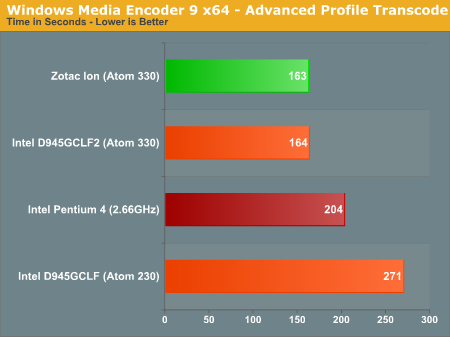
Again, the Atom 330 is faster than the Pentium 4 and again it’s due to the extra core. The Atom 230 is noticeably slower.
x264 encode performance is even more embarrassing for the Pentium 4; the Atom 330 is 62% faster in the first pass and 94% faster in the 2nd pass of the encode. The P4 system was 15% faster than the Atom 230 in the first pass and around 5% faster in the second pass.
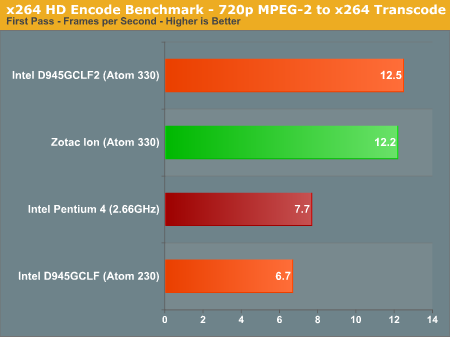
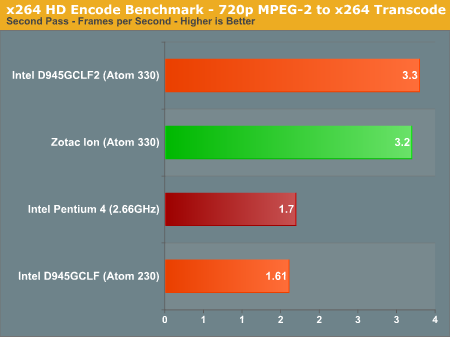
Next up was Cinebench. This is an interesting benchmark to look at because it offers both a single-threaded and multi-threaded benchmark. The Pentium 4 without Hyper-Threading can only execute a single thread, so the multi-threaded test can’t run. I’ve combined the meaningful results in a single chart:
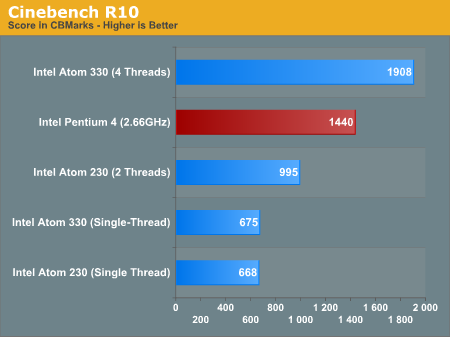
If we look at single-threaded performance, the Pentium 4 destroys the Atom - offering more than twice the performance of the svelte Atom core. Enable the multi-threaded render and the Atom 330 pulls ahead by 33%. This is the strength of the Atom; it’s clearly not faster than the Pentium 4 when working on a single thread, but exploit its ability to work on four threads simultaneously and it can actually be faster than a much larger, much more power hungry Pentium 4. This is a very important point to remember because despite losing to the Atom 330 in nearly all of the benchmarks, the Pentium 4 system it felt much faster than the Atom system in normal usage.
Simple things like opening up Control Panel or switching between windows felt faster on the old Pentium 4 system, which makes sense given that those tasks only spawn a single thread. In Cinebench we saw that the single-threaded performance of the old Pentium 4 was over twice as fast as the Atom - you tend to notice performance differences of that magnitude.
The final application test I ran was our WinRAR compression benchmark:
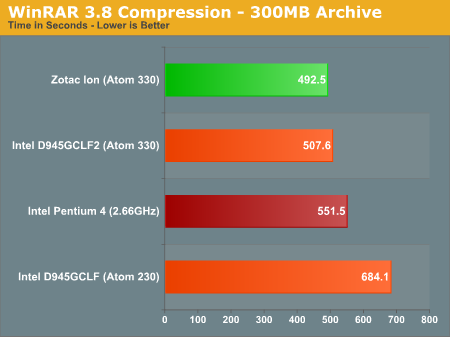
Once more, the Pentium 4 gets beat by the Atom 330 but turns the tables on the Atom 230. Even file compression is multi-threaded these days, and that is the Atom’s saving grace.
I wanted to know how well the GeForce 9300 could stand up against the old Dell’s Radeon X800 XT so I ran my WoW test on both systems. This is less of a CPU test and more of a CPU + GPU test obviously, but the results are interesting:
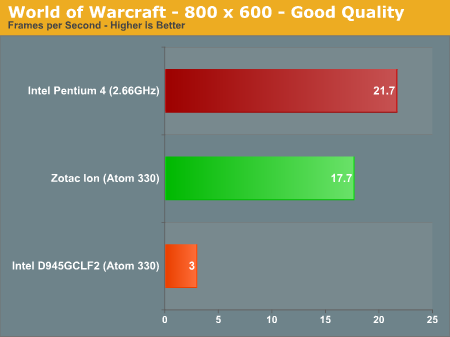
The Pentium 4 + X800 XT system is clearly faster, but not by as much as I expected. The advantage amounts to 22.5%, which is very noticeable, but close enough that if you had an even older system (or one with a lesser video card) you might not notice the performance difference between it and the Zotac Ion.
The last benchmark I ran comparing the Atom to a Pentium 4 was Futuremark’s Peacekeeper - a benchmark for measuring web browser performance. The benchmark is unaffected by internet connection and simply measures, once loaded, how fast your PC can work with various forms of commonly used javascript. I ran all of the Peacekeeper tests using Google Chrome:
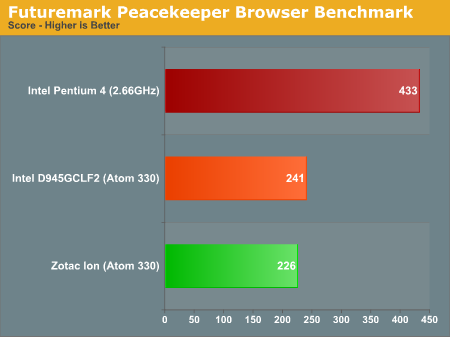
The Pentium 4 absolutely demolished the Atom here. Once again it’s almost twice as fast as the Atom 330. In a multi-threaded environment the Atom 330 can pull ahead, but in most typical day-to-day tasks the Pentium 4 is going to be a much faster solution.
Power efficiency is obviously where the Atom based Zotac Ion wins out. AMD and Intel both viewed the move to multiple cores as a performance and power efficiency win, and the results below help show that. Granted Atom is built on a 45nm process and we’re looking at a 130nm desktop Pentium 4 system, which is where much of the difference really comes from. But the results do show you that if you don’t need top bin performance you can build a very capable PC these days with significantly better power consumption characteristics.

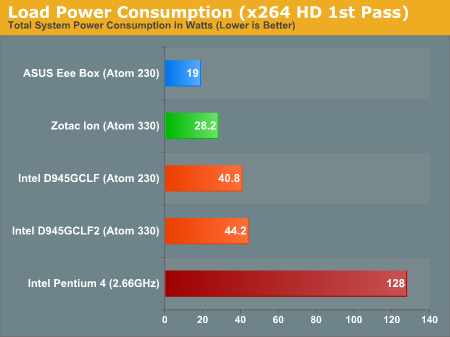
NVIDIA is forever arguing with me about how Atom and its Ion platform is a significant upgrade to PCs that are a few years old. My Pentium 4 results show that unfortunately, that’s not exactly the case. The Pentium 4 system I compared Zotac’s Ion to could never function as a modern-day HTPC and it won’t play Blu-ray discs. In those senses, Zotac’s Ion would be a tremendous upgrade. Even in multi-threaded CPU bound scenarios such as video encoding or 3D rendering, a dual-core Atom 330 is appreciably faster than the old Pentium 4 based Dell system. However, in normal web browsing and simply interacting with Windows, the Pentium 4 is significantly faster. The benchmarks show a nearly 2x performance advantage in single-threaded applications and I’d say they are accurately reflected in the usage experience.










93 Comments
View All Comments
nubie - Tuesday, May 12, 2009 - link
Assuming the price is under $180 for the LGA 775 board that would be my choice.You can passively cool a Celeron 420, 430 or 440 and pick one up for $25-30 on ebay. The Conroe-L will absolutely murder the Atom for any gaming or encoding, and most of them will bump to 1066 without a voltage increase.
The 775 board is $139 with free shipping.
http://www.newegg.com/Product/Product.aspx?Item=N8...">http://www.newegg.com/Product/Product.aspx?Item=N8...
Throw an e5200 or Celeron DualCore at it and just laugh at the Ion platform trying to keep up.
Don't forget the PCI-e 2.0 x16 slot so you can game too if you want.
My choice is pretty clear, forget ION for the desktop unless you really need one of the features (DC power, ultra-low consumption, just can't afford the extra $20-40) the LGA 775 is the better choice for future-proofing an ITX platform. And chances are you have the CPU and heatsink laying around (I know I do.)
If they can get a 32nm Desktop processor at 15-20 watts (for the CPU) instead of that Atom I would love to see it.
strikeback03 - Wednesday, May 13, 2009 - link
I'm not sure I would call anything on LGA 775 future-proofing, as all the processors we are going to see for that socket are now out. So yes performance would be better than Ion, but it would still be a system with almost no room to upgrade.nubie - Thursday, May 14, 2009 - link
I meant future-proofing as in "allowing the platform to remain viable into the foreseeable future." And in comparison with the Atom board it is infinitely future-proof (X16 PCI-e 2.0 and an LGA socket will do that.)You can't argue that a 3.0ghz Quad core won't work adequately for the next 5 years on any conceivable OS, whereas this Atom processor is struggling even now.
Not to mention the PCI-e 2.0 x16 slot, what happens when the 9300 doesn't cut it anymore? The Atom platform has no room for upgrade.
If they cost the same when you outfit the LGA 775 motherboard with a Celeron (and the celeron is much faster), with the option down the road of a dual or quad core and any video card you want, I would say in comparison to the Atom board it is future-proofing.
strikeback03 - Thursday, May 14, 2009 - link
If power consumption is a concern though, you won't ever be using a Penryn quad-core. Due to the memory controller it is highly unlikely any motherboards from the Penryn era will be usable with future processors, so for low power usage an Atom board now and something else low power in a year or two is more likely the way to go.dEad0r - Tuesday, May 12, 2009 - link
Why are there different versions of that platform?Today Computerbase released their review of the "Zotac IONITX-A", which features the same CPU, but offers the faster Nvidia 9400 graphics card onboard.
So all the gaming benchmarks should be way better.
http://www.computerbase.de/artikel/hardware/mainbo...">http://www.computerbase.de/artikel/hard...dia_ion/...
As you can see, for World in Conflict, Doom 3, F.E.A.R. and Company of Heroes are fully playable at 1024x768 1xAA/1xAF, as the ION gives us ~30 fps in those tests.
JarredWalton - Tuesday, May 12, 2009 - link
Don't get too carried away: the 9400 runs at 580/1400MHz core/shader clocks while the 9300 runs at 450/1200MHz core/shader clocks. Assuming games aren't bottlenecked by memory bandwidth, the 9400 is about 20% faster - so it could equal the X800 XT.Those benchmarks you link show the GeForce 9400 as being around six times faster than the 945G chipset, which is quite similar to the results Anand shows in WoW. I'm guessing that the details are set to low or medium in order to get many of those games to 5-6FPS with the GMA 950.
Pirks - Tuesday, May 12, 2009 - link
when you have this: http://www.newegg.com/Product/Product.aspx?Item=N8...">http://www.newegg.com/Product/Product.aspx?Item=N8...sprockkets - Tuesday, May 12, 2009 - link
Because that board is crap compared to the Intel LGA board in the article.It lacks a x16 pci-e slot, wifi isn't built in, needs laptop ram and has no optical or coax audio out. Plus, Linux easily supports PureVideo; no such tech I know of for Ati. While this does feature more SATA ports, I can live without that.
And you rather pay $20 more for that?
Visual - Wednesday, May 13, 2009 - link
dude, the atom mini itx boards also don't have pci-express 16x. intels have a pci just like this amd, the ion one has mini-pci-e which is just 1x and it is ment to be used with the bundled wireless card - it will be quite hard to find other devices for it.where did you get that 16x from?
sprockkets - Thursday, May 14, 2009 - link
Are you capable of looking at the specs yourself of the LGA board in the article?Or, look here: http://www.newegg.com/Product/Product.aspx?Item=N8...">http://www.newegg.com/Product/Product.aspx?Item=N8...
I accept your apology Pirks.